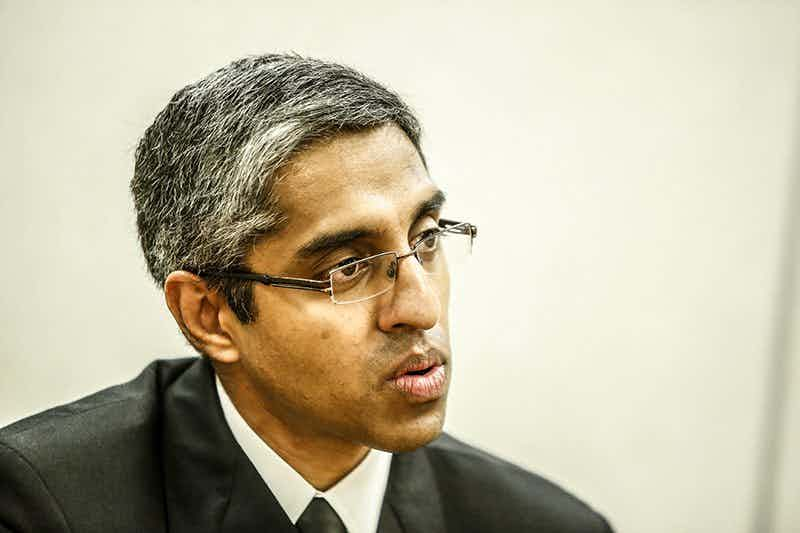The U.S. Surgeon General today issued a report on e-cigarettes and youth that focuses entirely on potential risks of teen and young adult use, and ignores the massive benefits to public health that would come from encouraging adult smokers to adopt vaping. The release was accompanied by a press conference that opened with an introduction by a 16-year-old ex-vaper.
There is no new information in the report. It's strictly an intentionally panicky rehash of what we've seen before from the various public health agencies of the U.S. government. In fact, though the report bears the name of Vivek Murthy, the 19th Surgeon General of the U.S., it was produced by the the Centers for Disease Control and Prevention (CDC), specifically that agency's Office on Smoking and Health.
"</p> <blockquote><p>We know what works to effectively prevent tobacco use among young people. Now we must apply these strategies to e-cigarettes—and continue to apply them to other tobacco products. To achieve success, we must work together, aligning and coordinating efforts across a wide range of stakeholders. We must protect our nation’s young people from a lifetime of nicotine addiction and associated problems by immediately addressing e-cigarettes as an urgent public health problem. Now is the time to take action.</p></blockquote> <p>"
Surgeon General Vivek Murthy, "E-cigarette Use Among Youth and Young Adults"Unlike the reports from Public Health England and the Royal College of Physicians, this one completely ignores the potential of vaping to save the lives of committed adult smokers and to divert experimental teens from cigarettes. Public health officials in the U.S. have consistently ignored the reality that about 40 million Americans smoke and that restricting lower-risk products protects the cigarette market..
``The Surgeon General's report``
The power of titling a document "the Surgeon General's report" all flows from the Surgeon General's report, the 1964 report "Smoking and Health: Report of the Advisory Committee of the Surgeon General of the Public Health Service." That famous document from Surgeon General Luther Terry is widely seen as the starting point in the public health fight against smoking. (It was preceded by a similar report from the Royal College of Physicians in 1962.)
That report turned public opinion against smoking and tobacco. Because of the fame and reputation of that report, many will assume any Surgeon General's report is an unimpeachable source of dispassionate truth. This document could become the vaping bible for uninformed politicians and clueless local public health agencies, which could set the movement for safer nicotine alternatives back.
Panic!
Clearly the new report was written with the intention to create alarm. The front page of the Surgeon General's website tells parents everything they need to know to properly panic. "Besides nicotine, e-cigarettes can contain harmful and potentially harmful ingredients, including ultrafine particles that can be inhaled deep into the lungs; flavorants such as diacetyl, a chemical linked to serious lung disease; volatile organic compounds heavy metals, such as nickel, tin, and lead."
There's even a PSA to go along with the report.
"“This is just another politically-motivated attack on an industry that is helping people to quit.``"
- First, do no harm
- Provide information about the dangers of e-cigarette use among youth and young adults
- Continue to regulate e-cigarettes at the federal level to protect public health
- Promote programs and policies at the state and local levels to prevent e-cigarette use among youth and young adults
- Curb advertising and marketing that encourages youth and young adults to use e-cigarettes
- Expand surveillance, research, and evaluation related to e-cigarettes
The report walks right to the edge of claiming that vaping is a gateway to smoking, and stops just short of an outright recommendation to the FDA to ban flavored e-liquid. Clearly, some of the respectable scientists who were involved in the writing and review of the report insisted that unproven claims be left out. But there was little control over the conclusions, or the promotional material on the accompanying website. The website especially is truly a double dip of everything a puritan anti-nicotine zealot loves, with sprinkles.
Looks good to us, say the prohibitionists
Ultrafine particles are Stanton Glantz's favorite piece of unproven danger. Glantz, the University of California-San Francisco cardiology professor turned prohibitionist tobacco control dean, was so delighted that his pet fear made the cut that he published a summary of the report and a link to the Surgeon General's vaping website before the information was available officially. Naturally, Glantz was one of the report's reviewers.
"</p> <blockquote><p>"E-cigarette companies appear to be using many of the advertising tactics the tobacco industry used to persuade a new generation of young people to use their products," writes Frieden. "Companies are promoting their products through television and radio advertisements that use celebrities, sexual content, and claims of independence to glamorize these addictive products and make them appealing to young people."</p></blockquote> <p>"
Foreword to the Surgeon General's report by Thomas Frieden, Director of the CDCThe Times let its anti-vaping reporter Matt Richtel handle the story, rather than the more skeptical Sabrina Tavernise. Richtel didn't include any quotes from pro-vaping researchers.
The Washington Post balanced its quote from Myers (he was very busy Wednesday) with Dr. Michael Siegel's take on the report. "“Although electronic cigarette uptake has skyrocketed among youth, cigarette smoking has fallen at historic rates," said Siegel. "This would be nearly impossible to explain if electronic cigarettes were causing a substantial number of youths to start smoking."
"While the Surgeon General is rightfully concerned about the emergence of a vaping culture among young people, the truth is that this vaping culture is helping to displace a smoking culture," said Siegel. "All in all, this is a good thing.” He reminded readers of the report that "it is important that people understand the actual public health implications of the emergence of vaping, and it is nothing close to what the surgeon general has suggested.”
The Wall Street Journal mentioned the RCP report, and included a quote from American Vaping Association President Gregory Conley. “This is just another politically-motivated attack on an industry that is helping people to quit,” said Conley. They featured comments from Myers too.
Message to the future: don't be like we were
The real science is buried deep in the 298 pages of the report, but no one will read all that. The 28-page "executive summary" will get more attention, and the splashy graphics of the website will get the most. I wonder if all the honest scientists and reviewers whose names are included in this monstrosity had any clue how their work would be positioned. Or was the marketing ready to go before the science had even been reviewed?
This report is typical of what we're accustomed to from the CDC Office on Smoking and Health. With smoking in rapid decline, the CDC has repeatedly ignored the good news to spread fear about "other tobacco products." This is more of the same. In the U.K., where the promotion of health has been the guiding nicotine policy principle for the last few years, they must be mystified.
The danger of this report isn't that it identifies new concerns — it doesn't — but that it gives oxygen to the gasping anti-vaping ideologues. It will give news people a chance to trot out Frieden and Glantz and all the lesser lights of fear-based scientific communication. It will give them a chance to exploit average people's honest concern for their children in order to advance regulation and legislation that prevents adults from choosing a far safer product.
Ignoring the opportunity to convert adult smokers and prevent smoking uptake by teens to instead argue for strict controls that will at best maintain the status quo, and at worst send vapers back to cigarettes, the Surgeon General's report is a glorious example of the Frieden/Glantz anti-harm reduction ideology. It should be put in a time capsule.

Jim McDonald
Vaping for: 13 years
Favorite products:
Favorite flavors: RY4-style tobaccos, fruits
Expertise in: Political and legal challenges, tobacco control haters, moral panics
Jim McDonald
Smokers created vaping for themselves without help from the tobacco industry or anti-tobacco crusaders, and I believe vapers and the vaping industry have the right to continue innovating to give everyone who wants to use nicotine access to safe and attractive non-combustible options. My goal is to provide clear, honest information about vaping and the challenges nicotine consumers face from lawmakers, regulators, and brokers of disinformation. You can find me on Twitter @whycherrywhy


